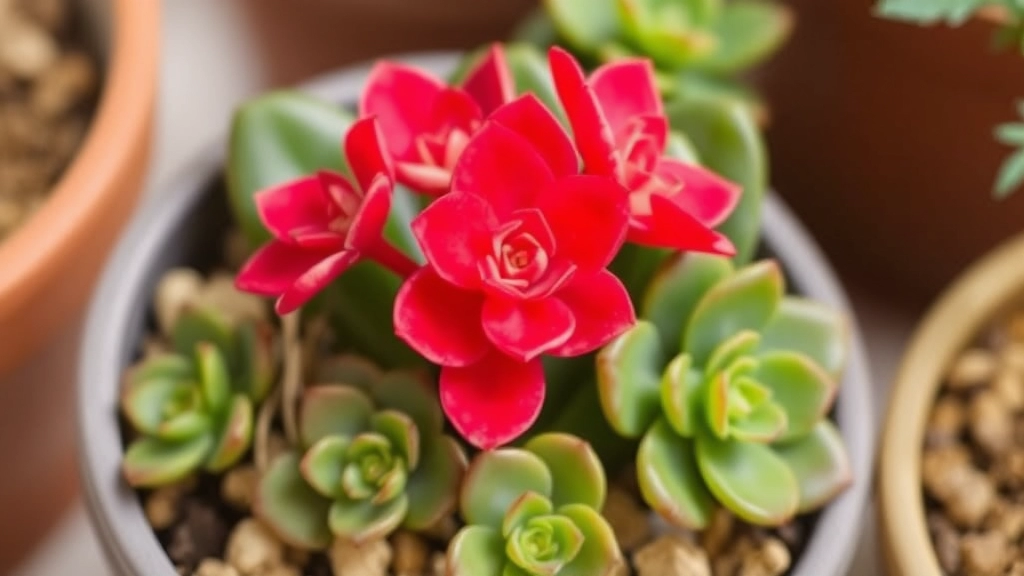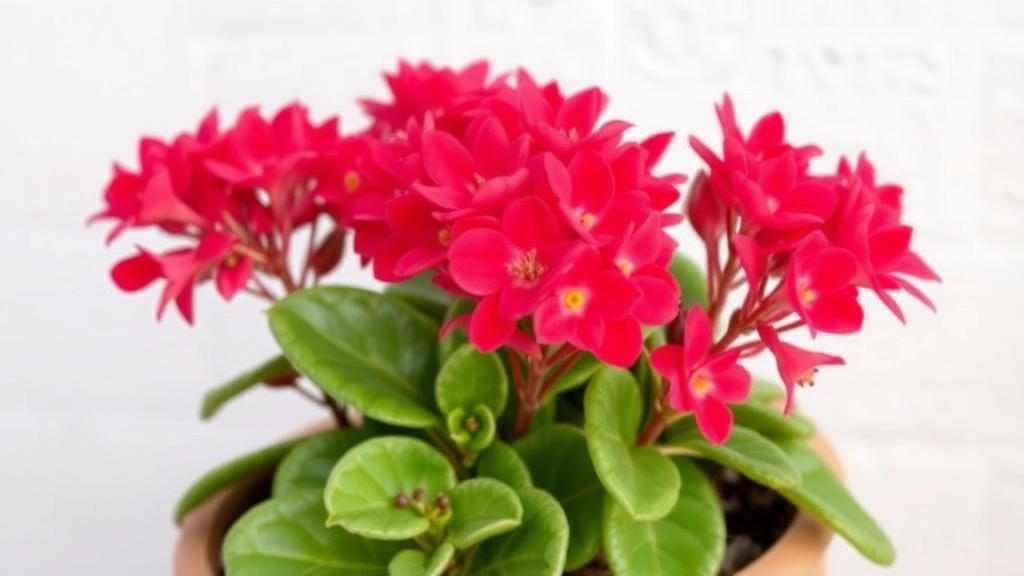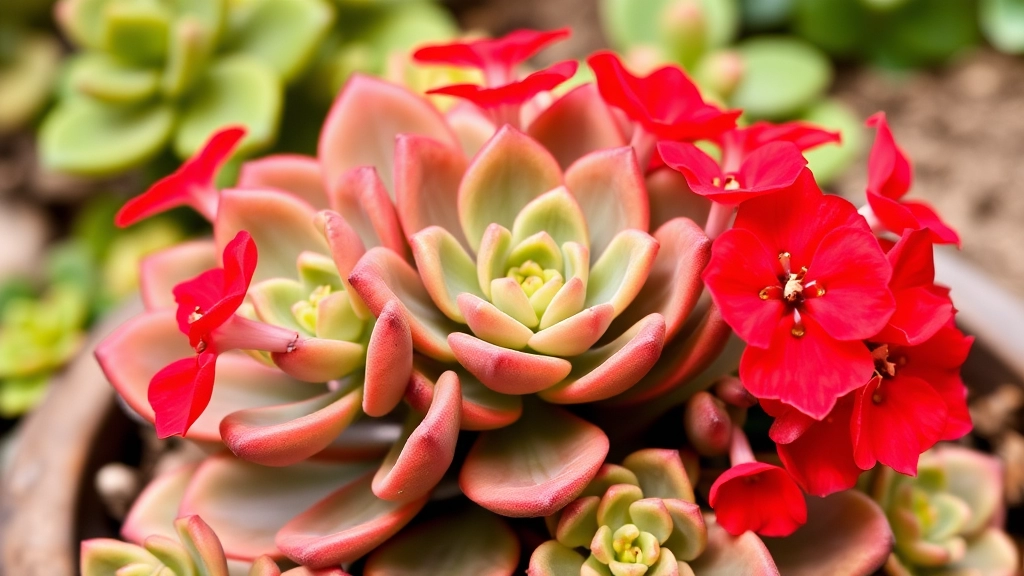Kalanchoe Succulents with Red Flowers
If you’re captivated by the vibrant allure of a Kalanchoe succulent with red flowers, you’re not alone. These striking plants, particularly varieties like the “Flaming Katy” (Kalanchoe blossfeldiana), are a favourite among succulent enthusiasts. Whether you’re looking to identify different types or seeking tips on how to care for these beauties, you’ve come to the right place.
Caring for Your Kalanchoe
Caring for a Kalanchoe succulent with red flowers is simpler than you might think. These plants thrive with the right balance of watering, lighting, and soil. To keep your Kalanchoe healthy and blooming, ensure it gets plenty of indirect sunlight and allow the soil to dry out between waterings. With a bit of attention, your Kalanchoe will reward you with stunning red blooms that can brighten up any space, indoors or out.
Top Kalanchoe Varieties With Red Flowers
When selecting Kalanchoe varieties with striking red flowers, it’s essential to know which types stand out. These plants not only add vibrant colour to your indoor spaces but also bring a touch of elegance. Let’s explore some of the top Kalanchoe varieties that showcase stunning red blooms.
1. Kalanchoe Blossfeldiana
This variety is one of the most popular.
- Features: Bright red flowers that bloom in clusters.
- Care: Thrives in bright light and requires minimal watering.
- Height: Typically grows up to 30 cm.
2. Kalanchoe Tomentosa (Panda Plant)
While known for its fuzzy leaves, this variety also produces lovely red flowers.
- Features: Unique red blooms that contrast beautifully with its silvery leaves.
- Care: Prefers indirect sunlight and well-drained soil.
- Height: Can reach up to 45 cm.
3. Kalanchoe ‘Calandiva’
A hybrid variety that offers multi-petal blooms.
- Features: Rich red flowers that last longer.
- Care: Requires bright light and moderate watering.
- Height: Grows up to 30 cm.
4. Kalanchoe ‘Fang’
This unique variety has spiky leaves and vibrant red flowers.
- Features: Distinctive appearance with bright red blooms.
- Care: Needs full sun and well-draining soil.
- Height: Can grow up to 60 cm.
5. Kalanchoe ‘Pink Butterflies’
Though primarily pink, this variety can produce red flowers under the right conditions.
How to Care for Kalanchoe Succulents Indoors

So, you’ve got your Kalanchoe succulent and it’s looking good, but now what?
Caring for Kalanchoe indoors can seem tricky, but trust me, it’s easier than you think.
Basic Care Tips
- Temperature: Kalanchoe loves warmth. Ideally, keep it between 18-24°C. Avoid cold drafts and sudden temperature changes.
- Humidity: These plants prefer low humidity, so they’re perfect for most indoor environments. If your home is super humid, consider using a dehumidifier.
- Fertilising: Use a balanced, water-soluble fertiliser every few weeks during the growing season (spring and summer). Just dilute it to half strength.
Potting and Soil
- Potting: Choose a pot with drainage holes. Kalanchoe doesn’t like sitting in water.
- Soil: A well-draining cactus or succulent mix is best. You want it to breathe!
Watering
- Frequency: Water only when the top inch of soil feels dry. Over-watering is the biggest mistake you can make.
- Technique: When you do water, give it a good soak, letting excess drain out.
Light Needs
- Sunlight: Place your Kalanchoe in a bright spot where it can soak up indirect sunlight. Too much direct sun can scorch those beautiful leaves.
Pests and Problems
- Watch for: Mealybugs and aphids. If you spot them, a quick wipe with a damp cloth or a gentle spray of water usually does the trick.
When caring for Kalanchoe succulents, one of the most common concerns is how to get the watering and soil conditions just right. Overwatering or using the wrong soil can lead to stress and even death of these beautiful plants.
### Watering Guidelines
– **Frequency**: Water your Kalanchoe when the top inch of soil feels dry. This is typically every 2-3 weeks, but it can vary based on your indoor climate.
– **Method**: Use the soak-and-dry method. Water thoroughly until it drains out of the bottom, then allow the soil to dry completely before the next watering.
– **Signs of Overwatering**: Yellowing leaves or a mushy stem are clear indicators that you might be giving too much water.
### Soil Requirements
– **Type**: A well-draining soil mix is crucial. Look for a cactus or succulent potting mix, or create your own by mixing regular potting soil with sand or perlite. For more detailed information on soil, check out the [best soil for Kalanchoe Blossfeldiana](https://planthq.org/best-soil-for-kalanchoe-blossfeldiana-care-tips/).
– **pH Level**: Kalanchoe prefers slightly acidic to neutral soil (pH 6.0 to 7.0).
– **Pot Choice**: Ensure that your pot has drainage holes to prevent water from pooling at the bottom. If you’re interested in learning more about the general care of Kalanchoe succulents, visit our [expert tips on Kalanchoe care](https://planthq.org/how-to-care-for-a-kalanchoe-succulent-expert-tips/).
Tips for Encouraging Reblooming of Kalanchoe Plants

If you’ve ever wondered why your Kalanchoe has stopped blooming, you’re not alone. Many plant enthusiasts face this issue, especially with these vibrant red-flowering succulents. Fortunately, there are several effective strategies to encourage your Kalanchoe to rebloom.
1. Pruning After Flowering
- Once your Kalanchoe has finished its blooming cycle, prune the spent flowers and any dead leaves.
- This helps redirect energy towards new growth and blooming.
2. Adjusting Light Exposure
- Ensure your Kalanchoe receives adequate light.
- A minimum of 12-14 hours of bright, indirect sunlight is ideal.
- If natural light is limited, consider using grow lights.
3. Fertilisation
- Feed your Kalanchoe with a balanced, water-soluble fertiliser every few weeks during the growing season.
- Look for a fertiliser high in potassium to promote blooming.
4. Managing Watering Routine
- Allow the soil to dry out between waterings.
- Overwatering can lead to root rot, which inhibits blooming.
- Water less frequently during the dormant winter months.
5. Simulating Dormancy
- To encourage reblooming, simulate a dormancy period.
- Reduce watering and provide cooler temperatures for about six weeks.
- After this period, resume regular care to stimulate new growth.
6. Patience is Key
- Remember, Kalanchoe plants may take time to respond to care adjustments.
- Be patient and observe your plant for signs of new growth.
When it comes to nurturing your red-flowering Kalanchoe, lighting is crucial. Many plant enthusiasts often wonder why their Kalanchoe isn’t blooming as expected. The answer often lies in the light conditions.
Kalanchoe thrives in bright, indirect sunlight. Here are some key points to consider:
– **Direct Sunlight**: While Kalanchoe can tolerate some direct sunlight, too much can scorch the leaves. Aim for about 4-6 hours of direct morning sunlight.
– **Filtered Light**: If you can’t provide direct sunlight, filtered light works well. A sheer curtain can help diffuse harsh rays while still allowing ample light in.
– **Indoor Placement**: Position your Kalanchoe near a window that receives plenty of light. South or west-facing windows are ideal.
– **Signs of Insufficient Light**: If the leaves are stretching or becoming leggy, your plant may not be getting enough light.
As seasons change, so should your plant’s light exposure.
– **Winter Care**: During winter months, when daylight is shorter, consider moving your Kalanchoe closer to a light source.
– **Summer Caution**: In the summer, be mindful of the intensity of the sun. If temperatures soar, providing some shade during the hottest part of the day can be beneficial. For more detailed seasonal tips, check out our [Flaming Katy Kalanchoe Care Guide](https://planthq.org/flaming-katy-kalanchoe-blossfeldiana-care-guide/).
If you’re looking to expand your collection, you might also be interested in exploring the [Best Deals on Kalanchoe Blossfeldiana Varieties](https://planthq.org/kalanchoe-blossfeldiana-for-sale-best-deals-varieties/).
Common Pests and Problems to Watch For
So, you’ve got your stunning Kalanchoe with those gorgeous red flowers, but what happens when pests crash the party?
Here’s the lowdown on common pests and problems:
- Mealybugs: These little white cottony pests love to hide in the leaf joints.
- How to spot them: Look for white, fluffy spots on the leaves.
- Fix it: Wipe them off with a cotton swab dipped in rubbing alcohol.
- Aphids: These tiny green or black bugs can multiply quickly.
- How to spot them: Check the undersides of leaves; they often cluster there.
- Fix it: Spray them off with a strong stream of water or use insecticidal soap.
- Spider Mites: If you notice tiny webbing on your plant, these are the culprits.
- How to spot them: Look for fine webs, especially in dry conditions.
- Fix it: Increase humidity and spray with neem oil.
- Fungal Issues: Overwatering can lead to root rot or leaf spot diseases.
- How to spot them: Yellowing leaves or mushy roots are telltale signs.
- Fix it: Adjust your watering schedule and ensure good drainage.
- Leaf Drop: If your Kalanchoe is shedding leaves, it could be stressed.
- How to spot it: Sudden leaf loss can indicate a problem.
- Fix it: Review your care routineâcheck light, water, and pests.
Keeping an eye out for these common pests and problems can save your Kalanchoe from an untimely demise. For more detailed care tips, check out our ultimate guide to caring for Kalanchoe succulents. If you’re dealing with specific issues like leaf spots, our guide on white spots causes and treatments might be helpful.
FAQs About Caring for Kalanchoe Succulents with Red Flowers
How should I care for my Kalanchoe succulent indoors?
Caring for a Kalanchoe succulent indoors involves maintaining the right temperature, humidity, and light conditions. Keep the temperature between 18-24°C, ensure low humidity, and place the plant in a bright spot with indirect sunlight.
What type of soil is best for Kalanchoe succulents?
Use a well-draining cactus or succulent mix. This type of soil allows the plant to breathe and prevents water from sitting at the roots.
How often should I water my Kalanchoe succulent?
Water your Kalanchoe only when the top inch of soil feels dry. Over-watering can lead to root rot, so it’s crucial to let the soil dry out between waterings.
What should I do if my Kalanchoe stops blooming?
If your Kalanchoe stops blooming, try pruning spent flowers, adjusting light exposure, fertilizing with a high-potassium fertilizer, and managing your watering routine. Simulating a dormancy period with reduced watering and cooler temperatures can also help.
How can I encourage my Kalanchoe to rebloom?
To encourage reblooming, ensure your Kalanchoe gets 12-14 hours of bright, indirect sunlight daily. Prune after flowering, feed with a balanced fertilizer, and allow the soil to dry out between waterings. Simulate dormancy by reducing water and providing cooler temperatures for about six weeks.
What pests should I watch out for with Kalanchoe succulents?
Common pests include mealybugs and aphids. A quick wipe with a damp cloth or a gentle spray of water usually removes them effectively.
Can I use a regular pot for my Kalanchoe succulent?
It’s best to use a pot with drainage holes to prevent water from sitting at the roots, which can cause root rot.
Is it necessary to use a dehumidifier if my home is humid?
If your home is very humid, using a dehumidifier can help maintain the low humidity levels that Kalanchoe succulents prefer.
What temperature range is ideal for Kalanchoe succulents?
Kalanchoe succulents thrive in temperatures between 18-24°C. Avoid exposing them to cold drafts or sudden temperature changes.
How often should I fertilize my Kalanchoe succulent?
Fertilize your Kalanchoe every few weeks during the growing season (spring and summer) using a balanced, water-soluble fertilizer diluted to half strength.
References
-
The Spruce – Kalanchoe Succulent Care Guide
-
Gardening Know How – Kalanchoe Plant Care
-
HGTV – How to Care for Kalanchoe Plants
